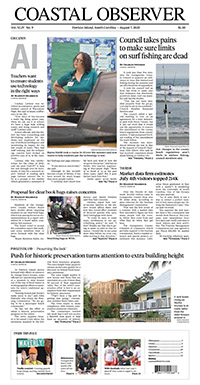Land use
Analysis shows zoning code allows 25,000 more homes

If the Waccamaw Neck develops under the zoning ordinance in place today, another 25,201 homes could be built before the area runs out of suitable land, according to data from consultants who are updating Georgetown County’s land use plan.
But if the area develops as envisioned by the current land use plan, only another 11,456 dwellings would be allowed, said Jake Petrosky, a community planner with Stewart, a North Carolina firm.
If the area develops as envisioned by the proposed update to the plan, the number of new dwellings would rise to 12,622, an increase of 10 percent, he said.
The numbers were compiled by consultants after the citizens group Keep It Green produced its own study showing the proposed land use plan would increase density on the Waccamaw Neck.
They estimated that the proposed plan would add over 4,000 residential units to what the current plan envisions.
“The bottom line is, everybody agrees this increases density. It’s unacceptable to the citizens,” said Cindy Person, chief counsel for Keep It Green Advocacy, who represents plaintiffs in five lawsuits challenging county land use decisions.
The plan is one of 10 elements of the comprehensive plan that local governments are required by state law to adopt and then revise every 10 years. The county’s current land use plan was adopted in 2007.
County Council gave the second of three readings to the updated plan over the objections of about 150 residents who attended a public hearing this week. The approval provoked a chorus of jeers and catcalls, leading the council chairman to ask deputies to help the audience leave the Howard Center quietly.
The land use plan sets goals such as promoting development in the western part of the county, preserving natural resources and maintaining the character of existing communities. Those come with implementation strategies, such as adopting a local wetlands ordinance and requiring that 50 percent of undeveloped land on Waccamaw Neck be maintained as usable green space.
The plan also contains future land use maps that provide the legal basis for zoning decisions.
Keep It Green produced numbers to show that the proposed maps would increase residential density and called on the Planning Commission to get its own data before approving the plan.
After the commission vote, which also drew a large crowd of opponents, the county asked the consultants, led by the Columbia-based firm Boudreaux, to do an analysis.
They looked at how much land is available, either because it is vacant or because it is occupied by a low-value structure.
“We based this on tax parcel data,” Petrosky said.
They then factored in features such as wetlands that would limit development.
The consultants applied the residential density allowed by land use classifications in the land use plan and the zoning ordinance. The current zoning allows a maximum of 16 units an acre. The proposed land use plan reduced the top limit to 12 units an acre.
For the county as a whole, where there were 35,665 housing units in 2020, 313,998 dwellings could be built if all the land was zoned as the current plan envisions. The current zoning, which determines what can actually be built, would allow 229,885 dwellings. The proposed plan envisions 168,265 dwellings.
“I don’t think we would ever get there,” Petrosky noted.
The county added 2,313 housing units between 2010 and 2020. All but 240 were on the Waccamaw Neck, he said.
“If it all happens on the Waccamaw Neck, then the Waccamaw Neck is going to be built out by 2050,” Petrosky said.
Before voting to move forward with the proposed plan, Council Member Stella Mercado confirmed that it would allow the county to rewrite its zoning ordinance to reduce the residential capacity from the 25,201 allowed under the current ordinance.
Person said the comparison between what zoning allows and what the land use plan envisions isn’t valid. Neither is the rationale that the land plan will lead to rezoning to lower density.
“You could downzone under the current plan today. You could have done it yesterday,” she told the council. “You could have done it last year. You could have done it 10 years ago.”




